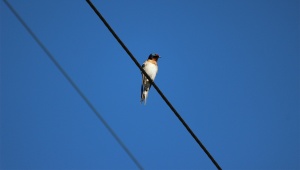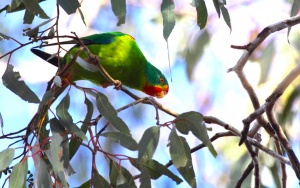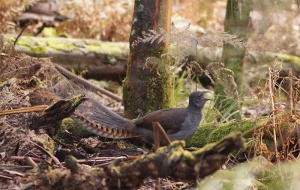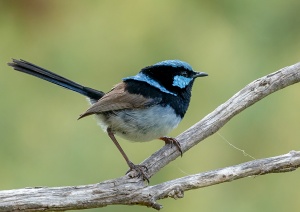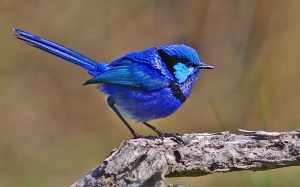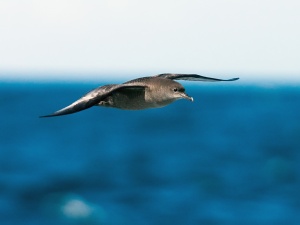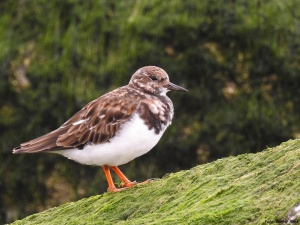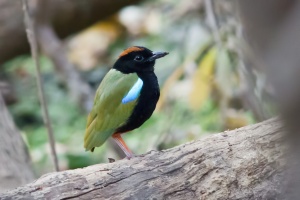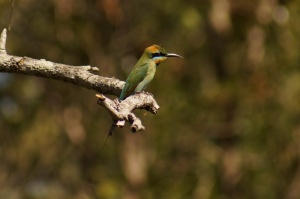Jen Sutfin
Welcome Swallow
Metallic blue-black on top and light to dark grey on its breast and belly. Its forehead, throat and upper breast are rust in colour. It has grey legs and feet, and its eyes and bill are black. A young Welcome Swallow has shorter tail feathers than an adult and its forehead and throat are a creamy beige (instead of rust).
Distinctive feature
A deeply forked tail with a white band or row of spots on the long tail feathers.
Swift Parrot
Mostly bright green, with a blue crown, cheeks and colouring on its wings. It has red around its bill, throat and forehead, and bright red patches under each wing. The red on its throat is edged with yellow and its long, pointed tail is purple-red. The female is slightly duller, with a creamy bar under its wings.
Size
About 25 cm; ; Wingspan 32 – 36 cm
Superb Lyrebird
A native pheasant up to 1 m, including tail. Plain rich brown above, coppery on wings, deep grey below; legs and feet dark grey, powerful.
Tail of male long and train-like, of two clubbed ‘lyrates’ about 60 cm long usually horizontal; glossy black and rufous above, silvery below, with notched ‘windows’; two slender, curved, ribbon-like guard-plumes’ and 12 lacy filamentaries, black above, silvery below. Moults annually. Full tail acquired at 6-8 years.
Tail of female (and immature male) is simpler, drooping and pointed, lyrates smaller, often hidden; typically looks twisted.
The nest is a bulky mound of sticks, bark, fern fronds and moss; on ground, bank, rock shelf, in stump or head of tree fern or to 25 m in a tree fork.
Superb Fairy-wren
Males have a rich blue and black plumage above and on the throat. The belly is grey-white and the beak is black. In non-breeding plumage, called eclipse, he is very similar to the female.
Females and young birds are mostly brown above with a dull red-orange area around the eye and brown beak. Females have a pale green gloss, absent in young birds, on the otherwise brown tail. Both sexes possess brown legs.
The nest is dome-shaped consisting of grass, moss, rootlets, twigs, spiders webs and other bramble. Found low in tussock, shrub or bracken.
Splendid Fairy-wren
The male is unmistakable in full breeding varying from cobalt-blue in the east of its range to violet-blue in the west with a pale blue head. Wings and long tail are brown with a blue wash. In non-breeding plumage, called eclipse, he is very similar to the female, being pale brown above and white underneath although he retains the blue wash on wings and tail. The young look like the females.
Distinctive feature
The magnificent blue colour of the male.
Size
14 cm
Short-tailed Shearwater
Commonly known as the muttonbird in Australia.It is one of the most abundant seabirds in Australian waters. They migrate to Australia in enormous flocks and often a number of birds are washed up on beaches and die as a result of exhaustion, sickness and bad weather.
Dark smoky brown body with a paler coloured throat, slender bill, light brown feet, narrow wings pointed at the tip, brown to grey-brown underwing colouration (some have whitish underwings), short rounded tail, body up to 43cm long, when flying black toes extend just past tail tip.
Nests on grass and leaves, and in burrows underground.
Size
40 – 45 cm long
Ruddy Turnstone
Stocky, medium-sized migratory shorebird with a short black bill and short orange legs. Back, head and upper chest is marked with black-brown and pale areas (tortoise shell-like) with a white breast. The bill is wedge-shaped and slightly up-tilted. In flight, there is a distinctive black and white pattern.
Distinctive features
The distinctive marking and dark and white pattern in flight make the Ruddy Turnstone unmistakeable, along with their habitat of turning over stones.
Red Wattlebird
A fleshy reddish wattle (skin flap) is on the side of the neck. Plumage is grey-brown on body, with prominent white streaks and yellow on belly. Face is pale and tail is long with a white-tip. Young Red Wattlebirds are duller than the adult and have a brown, rather than reddish, eye. The wattle is also very small and pale.
Its nest is an untidy saucer of sticks, leaves, and grass lined with bark-strips, fur, and hair; 2 - 16 m high in the fork of a tree or on a branch against trunk.
Size
33 - 37 cm long
Rainbow Pitta
A small native bird with a black head and breast, electric blue shoulder patches and white wing spots. Upperparts are bright olive-green, sometimes a silvery green-blue. The only pitta in the Darwin region, and Australia’s only pitta with a black head and breast.
Its nest is loose, interwoven sticks and dead vines, usually dome-shaped but can be a cup, with entrance at side or near top. It can be in a fork, on a branch, against butress root on the ground, from ground level to 8 metres above.
Rainbow Bee-Eater
A colourful bird, the upper part of its back is bright green, merging to light blue on the lower part to its rump. Its tail is black, tinged with blue, and has two long central feathers (called streamers) that extend beyond the tip of the tail. Its forehead is blue-green and the top of its head is golden. A bold black eye-stripe runs from the base of its beak and is bordered below by a narrow blue line. Its chin is yellow, changing to chestnut on its throat, below which is a broad black band. It has a green breast, becoming paler on the belly and changing to light blue from the lower belly to the vent. It has a long, slim, curved black beak and its legs and feet are grey-black.
Young birds are generally duller and greener. They lack the black band across the lower throat and the long tail streamers.
Distinctive feature
The sexes differ in the length of their tail streamers: the male has longer, more slender streamers.

